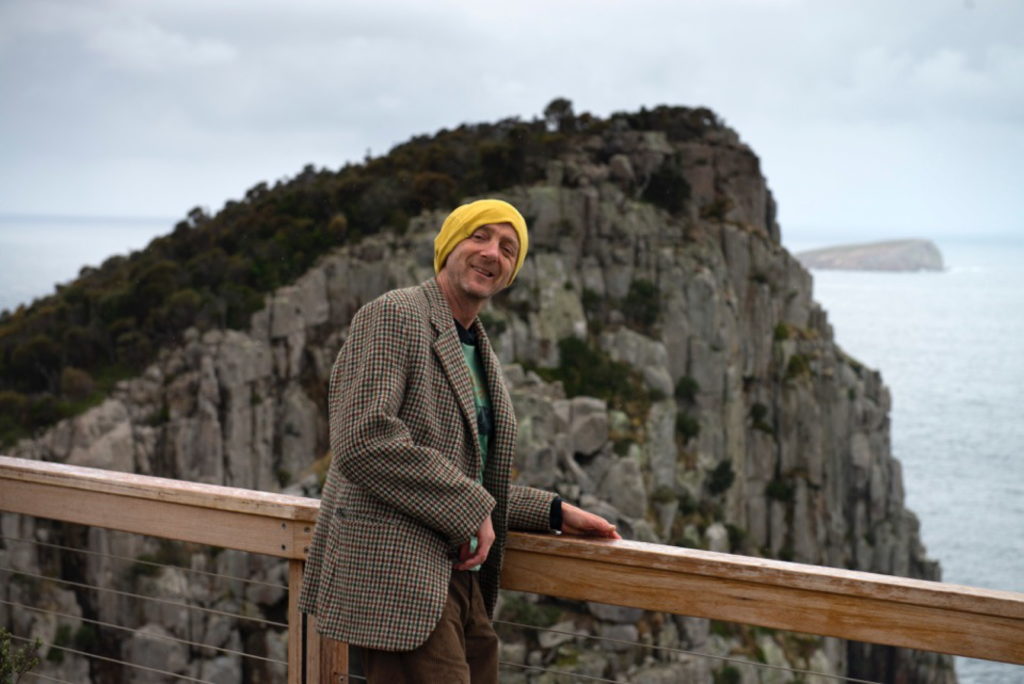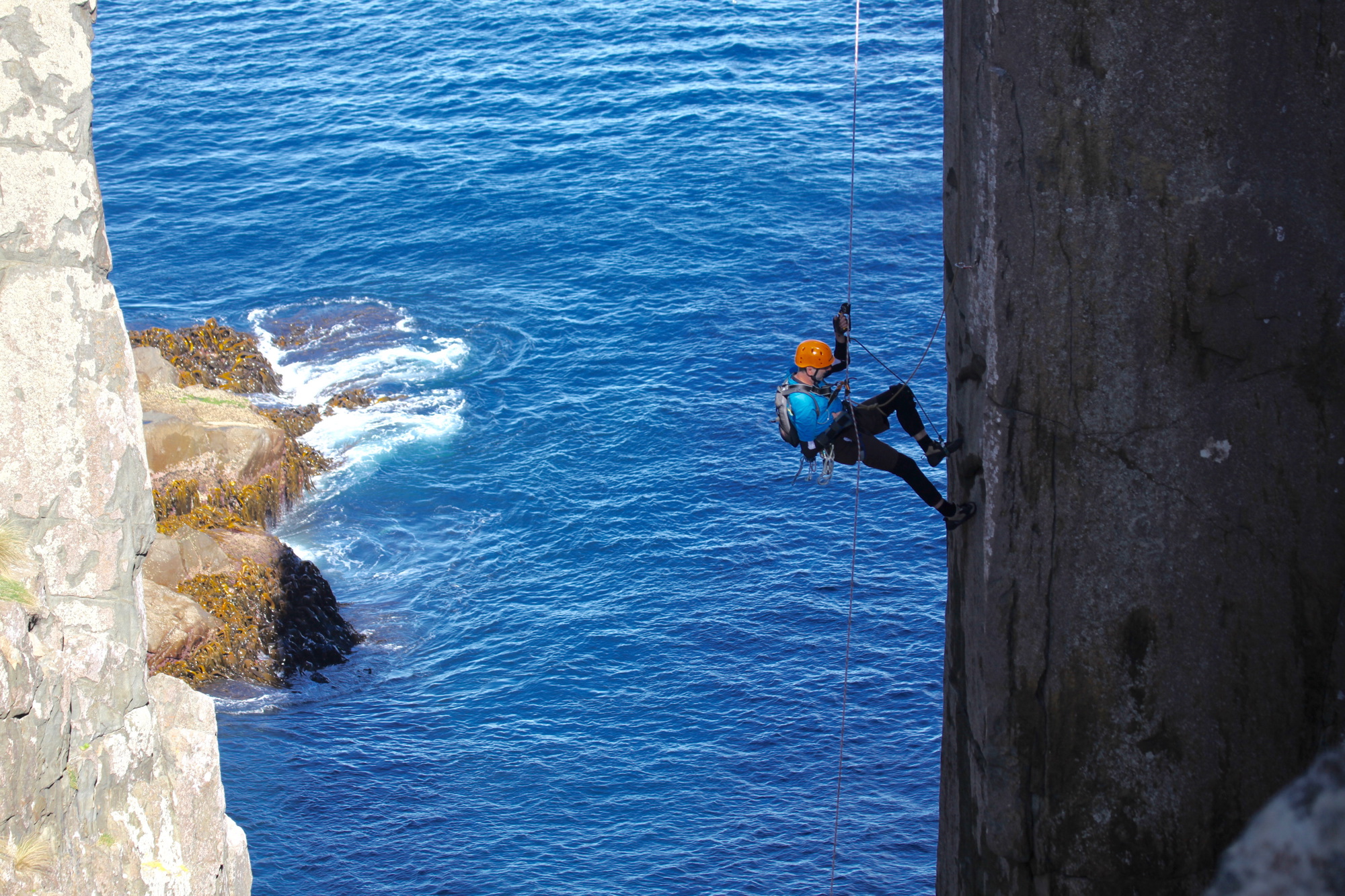Totem of recovery
Paul Pritchard was left partially paralysed after an accident at a notorious Tasmanian climbing spot. So how did he get back up it 18 years later?
As a youngster Paul Pritchard used to throw petrol bombs at climbers who scaled a quarry near his home in Bolton. Looking back, the now 49 year old describes his younger self as “a bit of a bad lad”, but says his lack of academic and sporting capabilities as a child led him to believe he would never be good at anything. But when Pritchard was 15, one of his schoolteachers arranged a climbing trip to Belmont’s Wilton Quarry. It was an outing that would change the course of Pritchard’s life.
“I took to it straight away,” says Pritchard. “It felt really good because I never knew that I could be good at anything. I finally felt like I had found myself.”
“Being on the dole really allowed me to concentrate on climbing and get good at it.”
Pritchard became an avid climber, taking on ascents in the Peak District and North Yorkshire. At 17 he made his new hobby a full-time commitment, moving to Snowdonia with friends so they could climb daily.
“When we first went out there we used to sleep in the women’s public toilets,” Pritchard remembers. “We used to tape the button shut on the hand dryer to get some heat from it.”
In Snowdonia, they carved out new routes and trails, contributing to the area’s growth as a tourism hotspot.
“We used to be involved in first ascents,” he says. “It was very creative because we were finding ways up cliffs that nobody has ever found before. And now, 30 years later, there’s a whole tourist industry based on the outdoors and rock climbing, and they are going up the same climbs that we climbed. It completely transformed this Welsh village – we transformed this Welsh village into a rock climbing mecca.”
Pritchard became one of the country’s leading climbers, but hobbies don’t pay the bills, and he would never have been so successful if it wasn’t for the welfare system that supported millions of people during the Thatcher years.
“It was in the 1980s when there were four million people unemployed and I really couldn’t find work, but one of the things about the Thatcher years was that it was very easy to sign on the dole. It was basically the first depression that was truly buoyed up by the welfare system.
“There are great artists and athletes who all appeared in the 1980s. JK Rowling wrote the first Harry Potter book on the dole. Hanif Kureishi got a knighthood and he started his career on the dole.
“Being on the dole really allowed me to completely concentrate on climbing and get very good at it. I don’t think I would have been able to achieve what I have without the welfare system. It’s quite paradoxical.”
In 1997 Pritchard’s first book, Deep Play, won the Boardman Tasker Prize for Mountain Literature. With the prize money, Pritchard bought two round the world tickets for himself and his then girlfriend Celia Bull. The pair travelled to Tasmania to climb the Totem Pole – a 213ft sea stack that peaks at the edge of the Tasman Peninsula.
“The Totem Pole is the most slender sea stack in the world. It is on any serious climber’s hit list. It is four metres wide by 70 metres high and it sways in the wind. It’s quite something. I remember the first time I saw a photo of it. I just thought: ‘I’ve got to do that.’”
On Friday 13 February 1998, Pritchard and Bull arrived at the Totem Pole. As the pair arrived they saw a rope connecting the mainland to the summit of the sea stack, and they decided that they would start at the summit before abseiling down and climbing back up.

“I went down the base of it first and I was just about to unclip when a wave came and soaked me through head to foot. I knew I couldn’t climb because it was too wet. I asked Celia if she could come down to the halfway ledge. She abseiled down and towed the rope off and I started to climb up the rope onto the ledge.”
A moment later, Pritchard’s abseil rope dislodged a rock, which fell down and hit him on the head. “I swung around the corner and that’s the last thing that I remember. I was hanging upside down and bleeding into the sea when I came round.
“It must have been about half an hour later because Celia was by me and she was trying to get me upright in slings. I was about a metre above the sea and she had to Jumar [mechanical device for climbing] me back up the rope to the ledge. It is the most astounding rescue by a female in mountaineering history.”
Bull climbed to the top of the Totem Pole and went back across the rope to reach the mainland. She then had to run eight kilometres to find help.
“I was on that ledge for 10 hours before a paramedic could abseil in to me. He clipped me to him and abseiled down into a waiting boat. We then sped eight kilometres to the beach and a waiting helicopter took me to hospital. I’d lost half of my blood and I was hypothermic.”
Pritchard was put into an induced coma and spent six weeks in hospital. He was suffering from hemiplegia – a condition that robbed him of feeling and movement in his right side and caused his speech and memory to suffer.
Pritchard was flown to Wirral’s Clatterbridge Hospital, where he spent the next year. But he remained partially paralysed.
It’s taken him 18 years of speech therapy to be able to talk and it took 17 years of physio and occupational therapy, to learn how to walk again. He still can’t move his right arm or walk without the aid of a stick.
The stress of the accident led to a breakdown of Pritchard’s relationship with Bull but he went on to marry nurse, Jane Boucher, with whom he has two children. After moving from the UK to Tasmania, he started making an annual pilgrimage back to the Totem Pole. “About four years ago I started to think: ‘Wow, maybe I could climb it.’ But obviously I couldn’t with my hands and my feet. I had to develop a one armed rope climbing technique.”
In 2016 Pritchard returned to the Totem Pole to finish what he’d started 18 years earlier. With the help of friend and mountain guide Steve Monks, he conquered the climb in 126 one-handed pull-ups using a rope.
“Returning to the Totem Pole was something I had to do. It’s such a beautiful place and I am always up for a challenge. It was just another challenge but it was also extra special because it was like closing a loop.
“I climbed the Totem Pole to prove that disabled people are not unable. I didn’t climb the Totem Pole – I climbed a rope up the Totem Pole and that rope is like a wheelchair ramp or even reading glasses. A wheelchair ramp means disabled people are more included in society, reading glasses mean people can sit an exam. It’s all the same. It just means that with support, like that rope, all people are capable of quite extraordinary things.”
Pritchard describes the catastrophic brain injury he sustained in 1998 as a gift, as it has allowed him to gain a clearer perspective on the world around him.
“My life through disability has improved massively. I now see things in a much clearer way. I was always a determined person but I have learned patience – you have to when you are in hospital for a year. I have learned how to accept what has happened to me, and that acceptance means that I treat everybody equally and I don’t think everybody does that. If you accept what has happened to you or your situation that doesn’t mean that you can’t strive to make things better, but with acceptance comes freedom.”

Leave a reply
Your email address will not be published.